Read the latest information on
Foot-and-mouth disease
As the colder months approach, growers should stay alert for hidden threats on their properties, which could endanger their crops.
Symptoms such as leaf scorch, dieback, or smaller fruit, may indicate the presence of two of Australia’s high priority pests and diseases: the Brown marmorated stink bug (BMSB) and Xylella fastidiosa (Xylella).
Both pest and pathogen pose a serious risk to plant production, potentially impacting yields, livelihoods, and market access.
BMSB: an expert hitchhiker
Native to Japan, Korea, China and Taiwan, BMSB is currently established throughout Asia and North America and has also spread to parts of Africa, South America and Europe. Australia has intercepted live and dead BMSB in imported vehicles and non-food goods, including machinery, general parts, and equipment. A recent detection involved a live BMSB found in luggage at Brisbane airport.
BMSB is a significant biosecurity threat, particularly between September and April, known as ‘BMSB risk season’. It affects more than 300 plant species, including a large portion of fruits, vegetables, and other crops.
During winter, BMSB seek shelter in vehicles, shipping containers, houses, luggage and clothing. This hitchhiking behaviour allows them to spread to new locations. They can also be moved with agricultural produce, especially fruit and vegetables or may hitchhike in packaging materials like wooden pallets, crates, or cardboard boxes. Once established, BMSB can fly short distances (up to a few kilometres), helping it spread locally. Wind and storm events can also assist passive dispersal over longer distances.
Despite mandatory offshore treatment for imported goods during the risk season, BMSB remains a concern due to its ability to remain hidden.
What does it look like?
Adult BMSB are between 12 to 17 mm long and are mottled brown, with white banding on their antenna and distinctive black and white banding around the abdomen. Nymphs go through five stages and range between under 3 mm to 12 mm long.
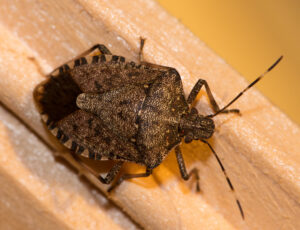
Image: Adult BMSB (Shutterstock)
Australia’s native stink bugs can easily be mistaken for BMSB. If you spot a brown stink bug with banding, especially in imported goods or luggage, immediately report it to the Exotic Plant Pest Hotline on 1800 084 881.
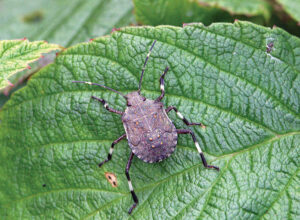
Image: Older BMSB nymph
What damage does it do?
BMSB feeds on a wide range of crops, including maize, soybean, sunflower, sorghum, peas, beans, cherries, apples, tomatoes, nuts, and berries. It causes significant crop losses by deforming pods and fruit and damaging internal plant tissue. Its feeding method of piercing the surface of plants, can create entry points for pathogens such as bacteria and fungi, which further threaten plant health and reduce yield.
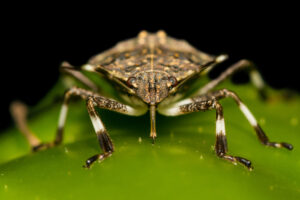
Image: BMSB feeding (Shutterstock)
For more information, refer to PHA’s BMSB factsheet.
Xylella: a drought mimic with deadly impact
Xylella is recognised as Australia’s most significant exotic pest. It’s not present in Australia and keeping it out is a national priority.
This bacterial pathogen infects more than 700 plant species and causes a range of diseases, including- but not limited to-bacterial leaf scorch.
Due to a recent detection in Mainland China, the Department of Agriculture, Fisheries and Forestry (DAFF) has imposed additional important conditions on nursery stock from China. This impacts a number of fruit, nut, truffle, and timber industries.
Xylella is also present in the Americas, Europe, Taiwan, the Caribbean, and parts of the Middle East. If introduced, it would be nearly impossible to eradicate, potentially causing long-term productivity losses and tree death.
What damage does it cause?
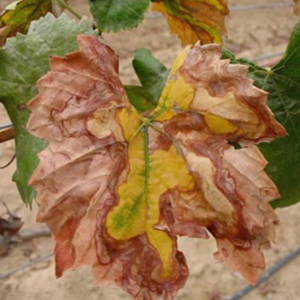
Image: Signs of Xylella Fastidiosa on a leaf (DAFF)
Symptoms vary by plant species but often resembles water stress, such as:
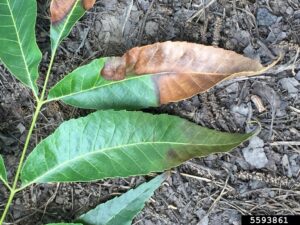
Image: Xylella fastidiosa symptoms presenting on a leaf (Rebecca A. Melanson, Mississippi State University Extension, Bugwood.org)
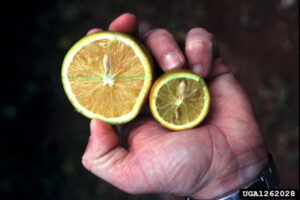
Image: A citrus fruit from a healthy plant next to a Xylella infected smaller fruit (Alexander Purcell, University of California, Bugwood.org)
For more information relevant to tree and nursery industries, see the PHA Almond leaf scorch fact sheet.
What can you do?
To prevent BMSB:
To prevent Xylella:
If you spot anything unusual, immediately report it to the Exotic Plant Pest Hotline on 1800 084 881.
Staying vigilant can keep Australia’s plant and agricultural industries safe.